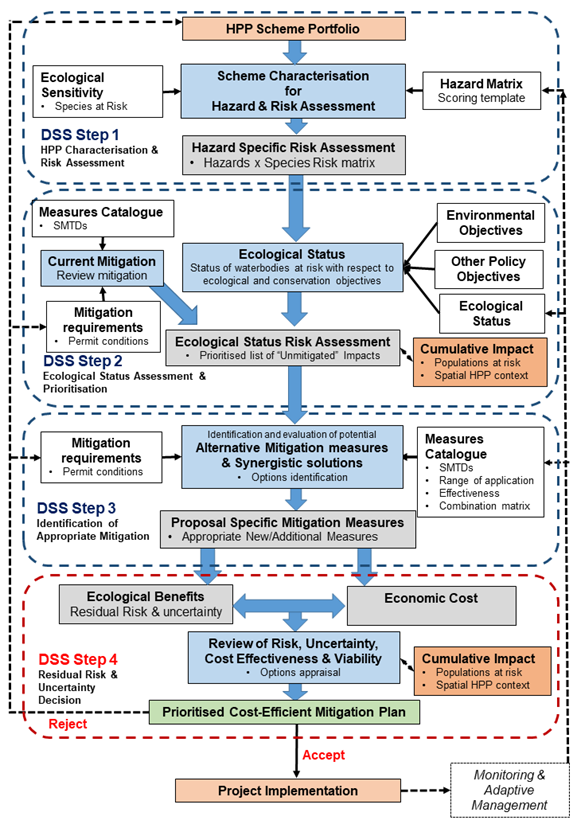Decision support system
Background
The proliferation of hydropower development to meet obligations under the Renewable Energy Directive has also seen the emergence of a conflict between the hydropower developers and the fisheries and conservation sectors. The hydropower industry wants a joined up response to their planned developments with sound guidance and timely decision-making. On the other hand, the fisheries and conservation interests have concerns over the impact that these schemes can have (especially the impact on WFD and Habitats Directive status) and want to be fully consulted on proposed schemes. As a result, there is a need to develop robust and transparent, evidence-based, support for decision making that is easy for developers and regulators to use while enabling a high level of appropriate environmental protection and mitigation.
Whilst many guidelines exist for assessing the sustainability of hydropower schemes or the need for retrofitting existing structures, they are often limited in their assessment of risks and uncertainty about the impact of schemes on fisheries and the environment. Few provide support for the decision-making process at each stage of evaluation. At each stage of the process, decisions have to be made about the acceptability of the risks and uncertainty of impacts of hydropower schemes, and the ability to manage those risks.
Decision Framework
The FIThydro Decision Support System (DSS) is based on a planning and decision framework comprising a sequence of four key steps, each encompassing a series of key considerations and decisions. The framework enables operators and regulators to develop structured proposals for new HPP schemes, and to both, review and risk assess, those proposals whilst identifying appropriate mitigation measures to address the impact of both new and existing HPP schemes. The framework leads the decision maker through four key steps which act to characterise, risk-assess (and prioritise) the scheme(s) together with the identification of the most appropriate and potentially cost-effective mitigation options addressing the hazards and impacts arising due to the nature and context of the specific scheme(s).
The FIThydro planning and decision framework comprises a sequence of four key steps, each encompassing a series of key considerations and decisions. The framework enables operators and regulators to develop structured proposals for new schemes, review and risk assess those proposals and, additionally, identify appropriate mitigation measures to address the impact of an existing scheme or portfolio of existing schemes within a particular catchment or member state. The framework leads the decision maker through four key steps which act to characterise, risk-assess (and prioritise) the scheme(s) together with the identification of the most appropriate and potentially cost-effective mitigation scenario addressing the pressures and impacts arising due to the nature and context of the specific scheme(s). The four key planning steps are as follows:
- Step 1 Pre-screening characterisation, hazard identification & risk assessment
- Step 2 Ecological status assessment and review of existing mitigation
- Step 3 Identification of appropriate mitigation measures and synergistic solutions
- Step 4 Risk-based decision of scheme plan OR Scoping of detailed cost-efficient mitigation plan
These four steps lead decision makers from simple characterisation of a scheme and determination of its spatial and policy context, through a risk-based identification of hazards and impacts on sensitive fish species to identification of the most appropriate mitigation scenarios. The decision process leads ultimately to a structured assessment of the acceptability of a proposed scheme or scoping the measures required for mitigating existing hydropower plants, with associated risks and uncertainty.
Web tool implementation
The final FIThydro decision-support web-tool is based on the project management approach and outlines the steps that should be undertaken for the initial screening of a project to appraise the impacts, risks and scope options for further diagnosis and mitigation. Question catalogues, risk assessments and filtering tools are produced which cover aspects of ‘initial screening’, ‘ecological impacts’, ‘environmental status’, ‘mitigation measures’, and ‘risk and uncertainty’. Taken together, these aid the production of a project screening/scoping report designed to provide a systematic approach to decision-making for proposals relating to hydropower schemes and their mitigation. The DSS is presented in the form of an open access web-based tool which utilises and showcases some of the tools and outputs produced by the FIThydro project.
Conceptual workflow diagram of the Decision Support System web-tool – highlighting key steps (green), tasks/processes (blue), user inputs (yellow), system inputs/knowledge (white) and outputs (grey) – key questions and concepts are noted for each step.
Users/Uses
The FIThydro DSS web tool is aimed at regulators, engineering consultants, developers and operators and orientated around a single, risk-based, planning structure for scoping of mitigation plans for hydropower in relation to the impacts on fish populations. The planning and decision framework is designed to be sufficiently flexible to address decision making in two similar but contrasting scenarios (use cases):
- impact assessment and planning of new mitigation measures for existing HPPs.
- planning and risk assessment of a new HPP scheme proposal.
